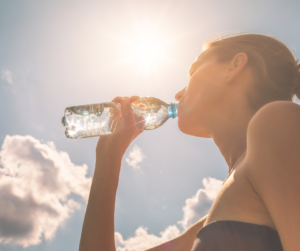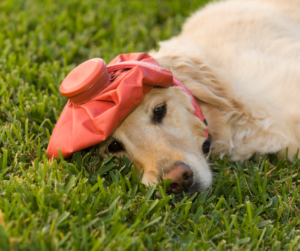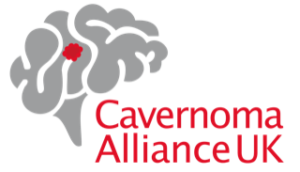The government has issued a Level 4 alert in anticipation of some of the hottest temperatures ever recorded in the UK, with highs of 40° possible in parts of England.
Many of you will already be feeling the effects of the soaring temperatures. Unlike many Brits who welcome the heat, those with cavernoma often find that hot weather worsens their symptoms and makes their condition even harder to mangage.
Common symptoms of cavernoma such as fatigue and cognitive impairment can be exacerbated by hot weather, many people find their headaches and migraines are triggered by the heat and those with sensitivity to light or difficulty regulating body temperature can struggle. Heat is also identified as a trigger for seizures for many people who have epilepsy as a result of their cavernoma.

We’ve put together some top tips for managing your cavernoma symptoms during the heatwave.
Hydrate hydrate hydrate!
It is vital to keep hydrated on a normal day living with cavernoma; keeping fluids up during a heatwave is an absolute must! It’s important to replenish the fluids our bodies lose in the heat when we sweat – drink plenty water, even when you don’t feel thirsty.
Try to avoid alcohol as it may contribute to dehyration.
Take care of medication
Many people with cavernoma take daily medication. Some prescribed medications can increase the risk of heat-related illness or may be less effective when exposed to high temperatures. Make sure your medication is stored at the recommended temperature and keep it out of direct sunlight. Always check the possible heat-related side effects on your medication’s information leaflet, or contact you GP to discuss your particular medication.
Keep cool
The use of cooling aids can be really helpful in extreme heat. Use an electric fan if you have one – if not, things like ice packs, cool gel pillows and cold wet cloths can help cool you down. Your freezer is your friend!
Try putting a wet cloth or towel in the freezer for a while, then pop it around your neck or across your forehead (this can be particularly effective if you are suffering from headaches or migraines). Have cold baths or showers, or splash cold water on your face.
Avoid the hottest part of the day
Keep out of the sun during the hottest parts of the day when UV rays are strongest (typically 11am-3pm). Keep your house cool by shutting the windows and closing the blinds in sun-facing rooms when its hotter outside than inside. Once it’s cooler outside, you can open the windows for ventilation.
Avoid moving back and forth between hot and cool environments unless necessary. The constant changes in your body’s temperature can exacerbate fatigue as your body struggles to regulate.
Avoid physical exertion. If you have to go out in the heat wear loose-fitting clothing, a hat and plenty sun cream. Take plenty water with you and walk in the shade.
Wear sunglasses and a wide brimmed hat! This could help stave off migraines and headaches for those who suffer from light sensitivity.
Look out for signs of heatstroke
Heat exhaustion is not usually serious if you can cool down within 30 minutes. If it turns into heatstroke, it needs to be treated as an emergency.

Signs to look out for, according to the NHS, are;
- dizziness and confusion
- loss of appetite and feeling sick
- excessive sweating and pale, clammy skin
- cramps in the arms, legs and stomach
- fast breathing or pulse
- a high temperature of 38C or above
- being very thirsty
The symptoms are often the same in adults and children, although children may become floppy and sleepy.
Find out more via NHS Heat-health advice
Our information does not replace medical advice. If you or a loved one becomes unwell or feels sick/dizzy during hot weather please keep out of the sun, move to a cool place immediately and seek advice by calling NHS 24 on 111.

